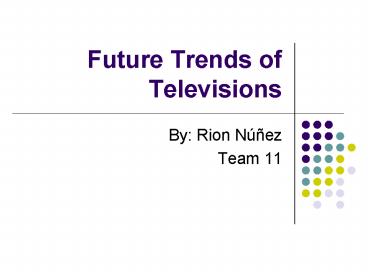Future Trends of Televisions PowerPoint PPT Presentation
1 / 28
Title: Future Trends of Televisions
1
Future Trends of Televisions
- By Rion Núñez
- Team 11
2
Types of Televisions
- CRT (cathode ray tube)
- Plasma
- LCD (liquid crystal display)
- DLP (digital light processing)
- OLED (organic light emitting diode)
- SED (surface-conduction electron-emitter display)
3
CRT (cathode ray tube)
- Invented in 1897 by Karl Ferdinand Braun
- Standard for televisions until recent years
4
How CRT works
- Acathode
- Bconductive coating
- Canode
- Dphosphor-coated screen
- Eelectron beams
- Fshadow mask
- Uses R,G,and B phosphors
- The three beams are accelerated and focused by
the anode
5
CRT Advantages
- High color fidelity and contrast
- Better resolution with moving images
6
CRT Disadvantages
- susceptible to phosphor burn-in
- Bulky and heavy sets
- Consume a lot of energy
- Old technology
7
Plasma Displays
- invented at the University of Illinois at
Urbana-Champaign in 1964 for the PLATO Computer
System - 1983 IBM introduced 19 orange on black
monochrome - Gas made up of free flowing ions and electrons
8
How Plasmas work
- Made up of tiny fluorescent lights
- Each pixel contains a red, green, and blue light
- xenon and neon gas is contained in hundreds of
thousands of cells positioned between two plates
of glass along with electrodes - When charged, it releases ultraviolet photons
which act with the phosphors - This brings their energy level up, when it goes
back down it is released as visible light photons
9
Plasma Advantages
- Brighter than CRTs
- Flat panel
- Lowering in cost
10
Plasma Disadvantages
- Susceptible to phosphor burn-in
- Not well used in bright rooms
11
LCD (liquid crystal display)
- Liquid crystals were first discovered in 1888, by
Austrian botanist Friedrich Reinitzer - First experimental LCD by RCA in 1968
- Based on properties of polarized light
12
How LCD works
- Formed by two glass layers called substrates
- One is in charge of columns, and the other is in
charge of rows - Liquid crystals are sandwiched in between these
two layers - Uses a grid to charge specific pixels
- When this happens the crystals untwist and allow
light to pass through
13
LCD Advantages
- More efficient use of electricity than CRT
- Produce little glare compared to plasmas
- Largest screen sizes than other flat panels
14
LCD Disadvantages
- Manufacturers often reject about 40 of the
panels that come off the assembly line - Color contrast is not the best
15
DLP (digital light processing)
- Developed by Texas instruments
- Created by Dr. Larry Hornbeck in 1987
16
How DLP works
- One DLP chip contains more than 2 million mirrors
- Each mirror made of aluminum represents one pixel
on the screen - The chip will rapidly decode a bit-streamed image
code that enters through the semiconductor - It changes the data from interlaced to
progressive scanning and adjusts the picture - The mirrors then tilt off and on to allow light
to pass and can do it up to 5,000 times per
second - The is then sent through a transparent, spinning
color wheel that is synchronized with the chip
into red, green, and blue, light, and can produce
16.7 million colors
17
DLP Advantages
- Insusceptible to phosphor burn-in
- More affordable than plasmas and LCDs
18
DLP Disadvantages
- Not as thin as other high definition displays
19
OLED (organic light emitting diode)
- Developed by Eastman-Kodak
- Competing against LCD and plasma television
displays
20
How OLED works
- Has two to three layers of organic material the
emissive and conductive layer - These these are sandwiched in between the cathode
and anode - When an electrical current is sent through the
LED, it moves from the cathode to anode (negative
to positive) - The cathode gives electrons to the emissive
layer, and the anode takes away electrons from
the conductive layer - When they recombine, the extra energy is given
off as light which corresponds to the type of
organic molecule - The voltage also depends on how much light is
given off
21
OLED Advantages
- Thinner, lighter, more flexible
- Can be plastic instead of glass
- Does not require backlighting
- Brighter than traditional LEDs
- Consume less power than LEDs
- Large field of view around 170 degrees
22
OLED Disadvantages
- Easily damaged by water
- High manufacturing costs
- Blue OLED films have shorter lifespan than Red
and Green
23
SED (surface-conduction electron-emitter display)
- Formed in 2004 between Toshiba and Canon
- Created SED Co. LTD for developing and producing
SED technology - Canon for electron source technology
- Toshiba for the display
24
How SED works
- Uses millions of cathode ray tubes called SCEs
(surface-conduction electron emitters) - They have a layer of carbon with a gap down the
center - Half of the carbon layer is connected to a
negative electrode, the other to a positive - Activates SCEs all at once instead of CRT going
one row at a time - Does not use interlacing
25
SED Advantages
- Lower power consumption
- Fast video response
- High contrast of color
- 3cm thick
- Better picture than LCD and Plasma
26
SED Disadvantages
- Cost
- Availability
27
Extra
- http//www.youtube.com/watch?vhxv7mmKHRhs
28
Sources
- http//electronics.howstuffworks.com/lcd.htm
- http//electronics.howstuffworks.com/oled1.htm
- http//electronics.howstuffworks.com/plasma-displa
y.htm - http//entertainment.howstuffworks.com/sed-tv.htm
- http//www.howstuffworks.com/tv.htm
- http//www.howstuffworks.com/tv3.htm
- http//electronics.howstuffworks.com/dlp.htm
- http//reviews.cnet.com/8301-12760_7-9673322-5.htm
l?tagtxt - http//reviews.cnet.com/8301-12760_7-9674057-5.htm
l?tagtxt

